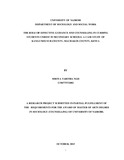| dc.description.abstract | The Government of Kenya in 1992 through its national policy on education highlighted
the need for guidance and counseling services in Kenya‟s educational system to address
the young people‟s apparent lack of awareness concerning skills on how to deal with
some social problems. This called for the training of teachers in the field of guidance and
counseling (Republic of Kenya, 1997). This study calls for an evaluation on follow-up of
what has transpired in our schools since then, for reports of rampant students‟ riot and
property destruction have continued to feature up to this moment. The study was guided
by the following objectives; nature of counseling interventions administered in schools,
Attitudes of students towards guidance and counseling, Effects of guidance and
counseling in reducing students riots and Factors that hinder effective guidance and
counseling.
The study employed descriptive research design. Both primary and secondary data was
collected. The study targeted 26 schools, 26 secondary school principals, 26 teachercounselors
and 7,510 students. The sample size was 12 schools, 12 school heads, 12
teacher-counselors in charge of G&C departments and 96 students. Stratified random
sampling and proportional allocation methods were used to sample and identify the
number of schools in different stratum. Systematic random sampling method was used to
sample the students involved in the study. Key informants were purposely sampled.
Structured questionnaire with both open and closed questions was the main instrument of
data collection. Interview guide was used to administer interviews for key informants.
The study findings reveal that most schools are offering more of group and entire school
forms of G&C than individual counseling which is more superior. The study found that
attitudes of students towards G&C are still negative. Findings on effects of G&C in
reducing students‟ unrests indicate that school riots are declining as more schools put
emphasis on G&C interventions. Most students concurred that G&C has helped them
resolve most of the problems they face hence contributed to a positive behavior change.
The study also found that there are many hindrances to effective G&C such as teachercounselors
lack relevant training in counseling, high teaching work load and lack of
financial support among others.
The study concludes that the remaining levels of unrests in schools are attributable to the
remaining unresolved students‟ problems that have not been addressed through group and
entire school forms of counseling. The study recommends that; schools should enhance
individual counseling which is more superior, specific efforts be made to particularly
improve attitudes of students towards G&C, G&C interventions be tailored to address
emerging family issues and stress management among students and finally, government
to work towards reducing syllabus load. | en_US |

